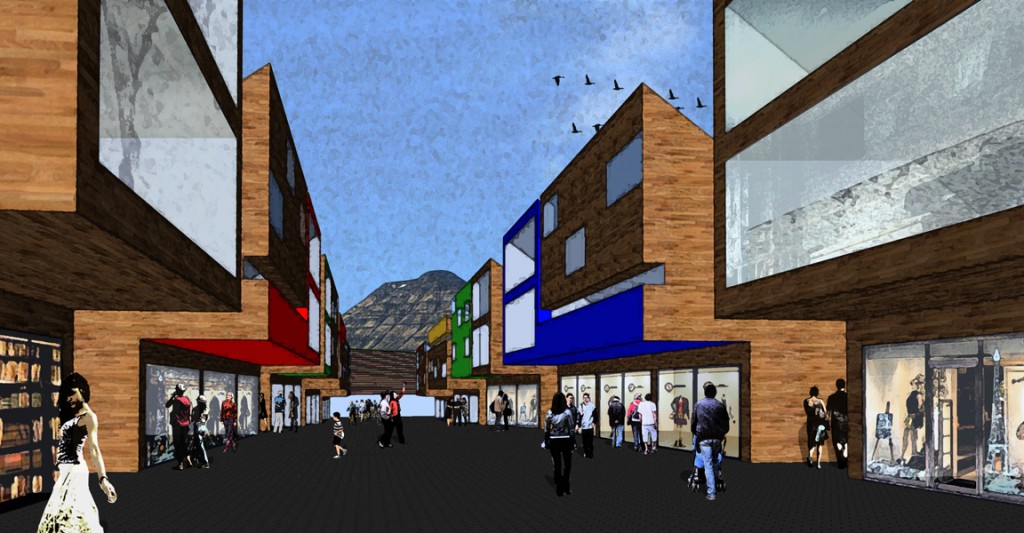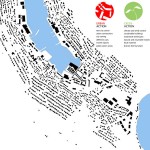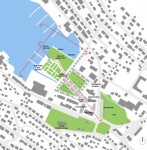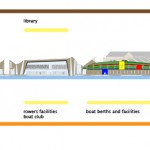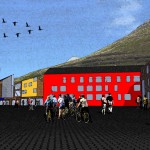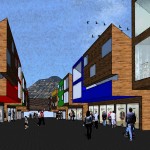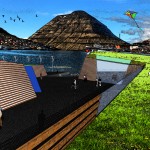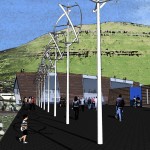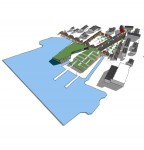Klaksvik, Faroe Island – Urban Design Competition
Il progetto per il nuovo centro urbano della città di Klaksvik, seconda località delle Isole Faroe per dimensioni ed importanza, si integra consapevolmente con il contesto urbano e naturale, curando le relazioni fra il nuovo e l’esistente senza intaccare le caratteristiche del luogo.
Il disegno di uno spazio pubblico pieno di potenzialità è un prezioso contributo per una nuova urbanità e per la creazione di nuove identificazioni sociali. Il progetto si propone quindi di organizzare un sistema di aree integrate con nuovi centri e servizi, caratterizzando gli spazi di uso pubblico all’aperto.
Il progetto prevede tre azioni principali per raggiungere questi obiettivi: azione urbana, verde e sociale.
L’AZIONE URBANA pianifica un denso centro città, che collega le diverse parti dell’abitato per ricucire i due lati di Klaksvik. Gli spazi pubblici sono progettati secondo i principi dello Shared Space, le diverse funzioni sono organizzate in modo da favorire più relazioni tra le persone e un utilizzo costante del quartiere durante la giornata. Le aree verdi inoltre creano nuovi punti d’incontro e aree riparate dal vento per svolgere le attività all’aperto.
L’AZIONE VERDE si propone di controllare il vento ed il clima, posizionando gli edifici in modo da fermare o rallentare il flusso del vento e realizzare aree protette negli spazi pubblici e percorsi protetti nelle vie commerciali. I nuovi edifici saranno sostenibili e saranno realizzati parzialmente con tecniche tradizionali e con l’utilizzo di materiali locali (tetti verdi, pavimentazioni e coperture in basalto). Gli altri materiali saranno naturali e riciclabili, ed è previsto un impianto termico di quartiere per ridurre il consumo di energia.
L’AZIONE SOCIALE prevede nuove polarità e punti d’incontro, offrendo maggiori servizi ai differenti utenti. Uno degli obiettivi è quello di creare vie commerciali organizzate in comitati di commercianti, artisti ed artigiani, e associazioni di quartiere per favorire la vita sociale dei cittadini.
Progetto realizzato da Marco Di Crescenzo, Beatrice Traspedini e Ludovico Milesi.
TARGETS
The project outlines a new townscape that fits in the context consciously, caring relationships between new and existing environment, so as not to spoil the values attributed to the place.
The design of a public space full of potential is a valuable contribution to a new urbanity, creating new social identifications.
The project aims to organize a system of integrated areas with new centers and services, characterizing open air spaces of public use.
THE THREE MAIN ACTIONS
The project has three main actions to achieve these targets: urban, green and social actions.
The URBAN ACTION plans a dense town center, connecting the different parts of the town to sew the two sides of Klaksvik. The public areas are based on the shared space principles, mixing the different functions to allow more relationship between people and to use the district at different times of the day. Green areas create new meeting places and safe areas for outdoor activities.
The GREEN ACTION aims to control wind and climate, positioning buildings to stop or decelerate the flux of the wind and realizing safe area in the public spaces and safe path in the shopping streets. New buildings will be sustainable and will be realized partially with traditional tecniques and local materials (grass roof, basalt flooring and tile). The other material will be natural and recyclable. It is provided a district thermal plant to reduce the energy waste.
The SOCIAL ACTION plans new polarities and meeting places, increasing in public service to offer facilities to different users. It aims to create shopping streets experienced by committees of merchants, artists and craftmen, and neighborhood courtyard to increase citizens associations and social life.
CONNECTION BETWEEN PROJECT AND HISTORICAL TOWN
The project has a close connection with the existent parts of the historical town, to increase the value of them on the whole urban design.
The new Southeast-Northwest street on the front of the sea, that connects the two sides of the town, crosses the old road and enhances the historical building on the East side. The new district will be integrated with the existent parts of the town, to make the whole harmonic and organic.
The new park, in the South of the project area, coincides with a large part of the ancient settlements of Vag Innangards, and includes the church “Christianskirkjan” and the old river.
The project preserves the West canal on the landfill side, in memory of the mouth of the old river, and the Southeast-Northwest street on the front of the sea increase the value of the old seaside.
The highest part of the large grass roof on the landfill offers a favorite sightseeing from the center of the bay, where is possible to see the whole town of Klaksvik and its natural context.
CLIMATE
The project is characterized by the climate of the region and the local climate.
The integration of buildings and streets with the urban surrounding determines orientation and layout.
The exposure to the prevailing wind plays a significant role in the urban design, planning areas with different permeability so as to control the intensity of the wind. The location of the buildings, the orientation and the section of squares and streets control the wind velocity, varying flows intensity to create safe areas for outdoor activities.
The project aims to exploit the potential climate, capturing wind energy with small wind turbines positioned on the front of the sea.
It is also provided a district thermal plant, exploiting the local conditions, to reduce the energy waste.
MATERIALS
The project aims to use natural and sustainable materials, in according to the availability of local materials.
Grass roofs are used for buildings in the area towards the sea, looking like headlands overlooking the sea, typical of the coast of the Faroe Islands, and for the shelter of the bus terminal. The grass turf for roofs is a local material and a traditional technique, that provide natural insulation and absorb rainwater.
Basalt stone is used for external flooring in the shared space and soft roofing for housing (tiles), but also for housing thermal and acoustic insulation (basalt wool).
The criteria in the selection of the other building materials are light weight, ease and sustainability of transportation, environmental impact and recyclability, carefully at the building’s life cycle.
SHARED SPACE
The public realm of the project – streets and places – shall be made up according to the principles of Shared Space. Shared Space is a type of urban form that facilitates interaction between residents of a community. These common outdoor areas are frequently jointly owned and maintained by the residents. The shared open space approach to conventional development achieves higher density. A radically different, human oriented streetscape is also created.
DIFFERENT STAGES OF DEVELOPMENT
The project is naturally splitted in different stages which can be developed in different moments.
The first stage is to build the district by the sea (multihall, library, rowers facilities and boat club, boat berths and facilities, fishing district and sea sailing museum) to create the new open air concert area on the large green roof.
The second step is to trace streets on the ground and to build the underground car parking, preparing the area to the future buildings.
As the streets will be traced, it will be easy for developers start building in what ever part they need.
The third step is to build the urban themes, starting from the Central Square (Administration building with Info Center, Touristic Info Point, the Cultural House and the Bus Terminal) and than the buildings on the main shopping streets (commercial and residential).
The last stage is to build the other residential and commercial buildings on secondary streets, according to the future request of the market.
DESIGNING WITH NATURE
The project takes inspiration from Faroe’s natural landscape to make a livable environment according to the traditional principles of nature lead design.
The urban sequence of places from the central square, through the shopping street, to the landfill with the multihall and the other facilities, is like an urban promenade that takes inspiration from the best town examples in Europe. At the same time the shape of the promenade mimics a natural path, with irregular bendings to create different views and different perceptions of the space. Also the promenade flooring is made with basalt stone, the natural and local material of the Faroe Islands, and the large green roof that stands out to the sea mimics a typical headland of the Nordic Landscape.
Furthermore, according to the nature lead design, also the new bus terminal will be placed under a big green roof, in continuity with the park’s field, to hide the structure in the landscape.
PLACE MAKING
The most important task in the urban planning is the interaction of streets, blocks, buildings, and open spaces. It is through the interplay of these components that a townscape is created and the livability of a town is determinated.
Streets are shaped with the idea that narrow paths are more pedestrian-friendly.
The Central Square is a typical urban theme which first appeared in European Towns during medieval ages. It’s a clear symbol of social life and of the town status. It usually hosts the most important buildings, like administration facilities, museums and, in our case, the post office.
The position of the new Central Square is due to the most important polarities of Klaksvik: the Church, the Post Office, the Banks and especially the big green areas between the two shores. These big fields will be enhanced and transformed in a real urban park with the memory of old natural environment and historical settlements together with new facilities typical of urban parks.
The two blocks are qualified by large inner courtyards: they are big and green areas at the service of the private buildings, and they can host neighborhood facilities like nurseries and playgrounds.
As it happens in traditional towns, the project is made up of different neighborhoods each one with its identity. That’s why the block nearer to the sea is shaped like a fishing district, with smaller buildings, narrow streets and boat facilities.
The principles of mixed use are also employed to improve the intensity of social interaction. A place with different uses means that it will be full of life in different moments of the day and night.

